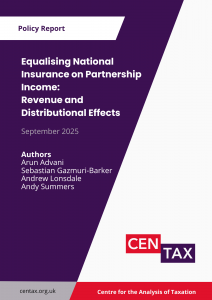
Equalising National Insurance on Partnership Income: Revenue and Distributional Effects
By Arun Advani, Sebastian Gazmuri-Barker, Andrew Lonsdale, and Andy Summers
This report models the introduction of an equivalent to Class 1 Secondary National Insurance Contributions (commonly known as ‘Employer NICs’) on partnership profits, which we refer to as ‘Partnership NICs’. We present novel statistics on the distribution of partnership profits in the UK and discuss how much revenue could be raised from our proposed reform. Our analysis draws on pseudonymised administrative data accessed via HMRC, which provides information on all taxpayers with partnership profits in the 2020 tax year.
Key Findings
- The top 0.1% of UK taxpayers by total income received 46% of all partnership income in 2020, compared with less than 5% of all employment income. This highlights the high concentration of partnership income relative to other forms of remuneration from work.
- 1800 partners in Kensington received over £1.8 billion in partnership income, exceeding the profits of all 65,000 partners in Wales and Northern Ireland combined. Partnership income in Kensington was 1200 times higher than in Liverpool Walton (£1.5 million).
- More than a quarter of UK partnership income went to taxpayers in just 12 constituencies, 11 of which are in London. Constituencies at the bottom of the distribution are highly urbanised, and largely in the North of England.
- Solicitors received one fifth (20%) of all partnership income, averaging over £300,000 each in partnership profits annually. Partnership income is also particularly high in finance, exceeding an average of £600,000 per partner in some sectors.
- Levying ‘Partnership NICs’ would raise an estimated £1.9 billion in 2026-27, after accounting for behavioural responses and interactions with other taxes. Since Partnership NICs would be paid from pre-tax profits, the tax increase is smaller than the headline rate: for an additional rate taxpayer the marginal effective rate would rise by 6.9 percentage points.
- 98% of the revenue from the proposed reform would come from individuals in the top decile by total income.
- 66% of current partners would have no tax to pay, due to the proposed Partnership Allowance and Partners’ Exempt Amount.
- Equalising the NICs treatment of partnership income with employment income would reduce economic distortions and be better for growth. The revenue raised from the reform could then be used to cut other taxes or to fund public spending.

